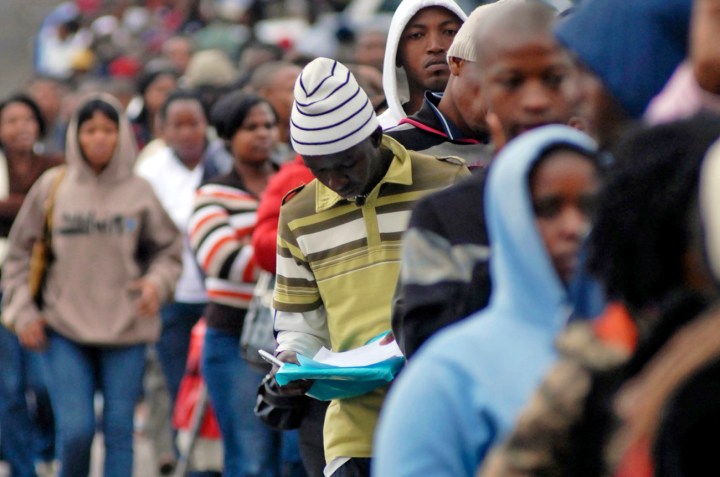Business Maverick, Politics
Analysis: The grim future of global employment

Joblessness, the most pernicious and lingering legacy of the worldwide financial crisis, will be the last to improve as the world begins its glacial crawl towards recovery. And SA’s high cost of labour riddles this long walk to work with potholes.
Close to or in double digits in many parts of the developed world, including the US, it is seen in its most acute form in Spain, where it is now more than 20%. Even worse, in the category of 18 to 25 year olds, Spanish unemployment is at a nightmarish 40%. Worrying numbers indeed.
The developing world has tended to fare better, where countries have the ability to soak up labour by paying relatively low wage. Unions have relatively little power and companies often get away with paying what would be deemed to be “slave-labour” rates in a western idiom.
South Africa finds itself in a strange situation. The country is neither fish nor fowl; neither fully developed nor truly developing either – and yet its official unemployment rate of 25.2% is chronic and shows few signs, if any, of improving. Unofficially, if disillusioned job seekers are added into the mix, unemployment is probably of the order of 35%-plus. It is extremely concerning from many aspects, notably the high crime rate it undoubtedly helps to fuel.
Stats SA recently released its Labour Force Survey which details unemployment in South Africa, both formal and informal. It makes grim reading, though there are a few nascent signs things may be improving, albeit at a glacial pace.
The LFS is a veritable mine of information which, if correctly interpreted, puts many things into stark relief. For example, in the second quarter of 2010, there were 31.4 million people between 15 and 65 old in South Africa. But not all of these people, for whatever reason, are deemed to be economically active; only 17.1 million are. Of the 17.1 million economically active people, 12.7 million were employed, while 4.3 million were jobless. And this is how Stats SA arrives at its unemployment rate: 4.3/17.1=25.2% (allowing for rounding in both numerator and denominator).
Of all the provinces, Northern Cape has the worst unemployment rate at around 30%, while KZN and Western Cape, at just more than 20%, fare the best. The formal sector accounts for 69% of employment, the informal sector 17%, private households 9% and agriculture 5%.
The actual employment rate, if shown graphically, is mildly encouraging: it appears that the graph is bottoming out. Theoretically at least, provided the economy keeps growing, employment should begin to improve in the not-too-distant future. Employment is what is referred to in economist parlance as a “lagging indicator”, and it is one of the last economic indicators to react to economic conditions, positive or negative. The reasons are fairly obvious; as an economy starts heading towards recession, firms tend to hold on to their staff, as they can’t be sure how long or profound the recession may be. A short, sharp recession can usually be coped with relatively easily, for example by putting surplus workers on shorter work times. But if it is more prolonged, firms tend to de-stock and eventually lay workers off. This is seen as a last resort, as hiring new people is a costly and difficult exercise.
And the converse is also true. Firms like to be very sure that an economic recovery is underway before they consider hiring new staff. Also, they tend to get used to working with fewer people and, in the process, labour productivity rises, often quite steeply. Thus, they tend to hold off on employing people until an economic recovery is well underway and is seen as being sustainable in the longer term.
This is probably where SA finds itself right now. We are three quarters of the way into a recovery and yet unemployment is still rising. Estimates vary among economists, as they often do, but it is probably safe to assume that, as a rule of thumb, an economic growth rate of around 3% is required just to maintain the status quo as far as unemployment is concerned. In other words, if economic growth declines much below 3%, jobs tend to be destroyed and if growth comes in much above 3%, jobs tend to be created.
Economic growth is the key to this problem. Governments cannot and should not be expected to create jobs. What they can do is create the conditions necessary for firms to hire more people. As things currently stand, SA will probably have an economic growth of about 3% this year, meaning that we should expect to see unemployment remaining pretty static. With a forecast growth rate of 4.1% next year, unemployment should begin dropping – albeit slowly.
But to make any meaningful inroads into our chronic and pernicious jobless rate, we need robust (5%+) economic growth sustained for a period of at least 10 to 15 years. That’s a big ask, especially when viewed against the current outlook for global growth, which is pretty subdued. And organised labour makes the problem doubly difficult by demanding wage increases well above the rate of inflation. Confronted by such demands, it is little wonder that firms are reluctant about hiring, preferring instead to extract even greater efficiencies from their existing workforces.
By Christopher Gilmour
(Gilmour is an analyst with Absa Asset Management Private Clients)
Photo: Thousands of hopeful job applicants queue for 200 positions advertised by the Metro Police Department in Durban September 9, 2009. REUTERS/Rogan Ward




















 Become an Insider
Become an Insider